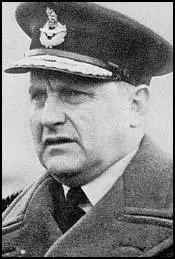William Sholto Douglas

William Sholto Douglas was born in Headington, Oxfordshire, on 23rd December, 1893. Educated at Lincoln College in Oxford, Douglas joined the Royal Field Artillery at the outbreak of the First World War.
In 1915 Douglas transferred to the Royal Flying Corps for observer training but later qualified as a fighter pilot. He eventually became a squadron commander and on one occasion duelled with Hermann Goering. During the First World War Douglas won both the Military Cross (1916) and the Distinguished Flying Cross (1917).
After the war Douglas became chief test pilot for the Handley Page Company before joining the Royal Air Force in 1920. He later became an RAF instructor at the Imperial Defence College.
In 1936 Douglas was appointed as director of staff studies in the Air Ministry. Two years later he was promoted to Vice Marshal and became assistant chief of air staff with responsibility for training and purchasing new equipment.
During the Battle of Britain Douglas was highly critical of the strategy promoted by the head of Fighter Command, Hugh Dowding and Vice Marshal Keith Park, the commander of No. 11 Fighter Group. Douglas, who was supported by Trafford Leigh-Mallory and Douglas Bader, argued that RAF fighters should be sent out to meet the German planes before they reached Britain. Park and Dowding rejected this strategy as being too dangerous and argued it would increase the number of pilots being killed.
Air Chief Marshal Charles Portal, the new chief of the air staff, agreed with Douglas and in November 1941, he removed Keith Park and Hugh Dowding from their posts. Douglas had the added satisfaction of taking over from Dowding as head of Fighter Command.
Douglas now developed what became known as the Big Wing strategy. This involved large formations of fighter aircraft deployed in mass sweeps against the Luftwaffe over the English Channel and northern Europe. Although RAF pilots were able to bring down a large number of German planes, critics claimed that they were not always available during emergencies and prime targets became more vulnerable to bombing attacks.
In 1942 Douglas was sent to Egypt to serve under Arthur Tedder. The following year he was appointed as Commander in Chief of the RAF in the Middle East. In 1944 Douglas was Commander in Chief of Coastal Command during the invasion of Normandy, where his main objective was to clear the English Channel of German naval opposition
After the Second World War Douglas became Commander in Chief and Military Governor of the British Occupation Zone in Germany and in January 1946 was knighted and promoted to marshal of the RAF.
Douglas retired from active duty in 1948 and was awarded a peerage as 1st Baron Douglas of Kirtleside. He served as chairman of British European Airways (1949-64) and in the House of Lords he supported the Labour Party.
William Sholto Douglas wrote two volumes of memoirs, Years of Combat (1963) and Years of Command (1966), before he died on 29th October, 1969.
Primary Sources
(1) William Shoto Douglas, Years of Command (1966)
Another of the bright schemes thought up for us was the free balloon barrage. This one originated in some fertile brain in the Royal Navy, and it called for the use of a whole lot of balloons with mines attached to the end of considerable lengths of wire. They were to be released from the ground in the path of the oncoming enemy bombers. It was much the same as 'Mutton' in its idea, but the great snag here, apart from the impracticability of the device, was a meteorological one. We were entirely dependent on the wind conditions being such that they would allow the balloons to rise in an effective way in the faces of the enemy bombers. But we had to try it out, and over a period of months we released the barrage on several nights without any apparent success, and eventually that also was abandoned.
